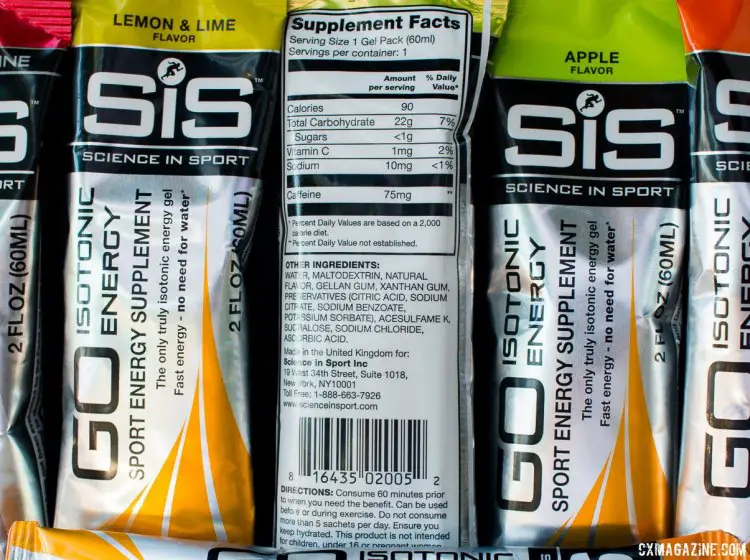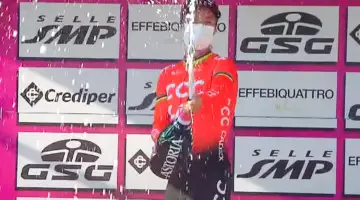Science In Sport is a large British sports nutrition company. You might not have heard of it, but it’s publicly traded as SIS on the London Stock Exchange, given new meaning to the acronym normally associated to Shimano Index System.
As a big British energy food brand, it should be no surprise that the company has secured two-time Tour de France Chris Froome champion as a sponsored athlete. Starting this weekend, the company hopes to not only lay claim to fueling the final yellow jersey winner on Sunday, but also market share in the North American energy food market.
The company has a number of energy and hydration products now available in the U.S., with an isotonic energy gel and hydration tablets being two of its main offerings for cyclists. We’ve sampled the new offerings and have some impressions below.

Science in Sport Go Gels are isotonic and are almost double in volume but don’t require water. © Cyclocross Magazine
Gel or Energy Drink?
Isotonic energy gel? What’s isotonic and why does it matter? We’re not biologists, scientists or nutritionists, but from our understanding, isotonic typically implies that a fluid has the same concentration of salt (and at times, sugars) as the human body’s cells. Gels are usually concentrated in small, convenient packages, but require water for nutrients to be absorbed efficiently and avoid pulling water out of your digestive system to balance out the gel’s salts.
Water is cheap and not hard to find, so what’s the big deal? It’s a matter of convenience and getting the concentration right. For our readers, the isotonic nature of Science in Sport’s Go Gel might be a welcome convenience come race day. The watered-down nature means you don’t need to carry a water bottle to wash down an energy gel at the start line, or when you’re seeing blurry but still have half the race left. Stick one in a jersey pocket or in your short’s leg gripper and forget the bottle and cage for hot early season races. Perhaps the bigger package also makes a convenient 90-calorie hand-up from your pit crew or teammate
The downside of an isotonic gel is either it has less salt or calories than a normal gel, or has more fluid to dilute a typical gel serving’s contents. In the case of Science of Sport, it’s a bit of both. A single serving is 2 fluid ounces, as opposed to a 1.2 ounce Clif Shot for approximately the same calories. To keep isotonic concentrations, it also ends up having less sodium than some gels, with 40mg compared to 90mg for a Clif shot (a Hammer gel has just 25mg).
A British Pill for Your Swill
Science in Sport’s Go Hydro Tablets are effervescent drink tabs similar in execution to offerings from companies like Hammer and Nuun, but different in packaging and quantity. Go Hydro Tablets come in a larger tube of 20 tablets (Hammer comes in 13 tablet tubes, Nuun in 10 tablet tubes). Each electrolyte tablet delivers 300mg of sodium, less than 1 gram of carbohydrate, and yet 9 calories (1g of carb = 4 calories) because of other ingredients like sorbitol, a sugar alcohol (more on that below). Other electrolyte levels are relatively similar to the popular NUUN tablets but with less magnesium, while Hammer, another popular option, offers lower sodium and more magnesium and potassium.

The Science in Sport Go Hydro Tablets add electrolytes, bubbles, flavor and less than a calorie to your water. © Cyclocross Magazine
The drink tablet is sweetened by low calorie sweeteners Sorbitol and sucralose. Sobitol is a sugar alcohol sweetener that’s also used in stronger concentrations as a laxative, so you may not want to consume a whole tube of tablets in a day, regardless of the duration of your event. Hammer also uses Sorbitol, Nuun does not.
Embrace the Taste
We’ve already tried both products, and always say when it comes to nutrition products that we’re not lab animals with controlled environments from ride to ride. Therefore won’t profess to be able to discern performance benefits over other products. We can comment on taste, packaging and value however, and so that’s what’s on tap.
The Go Gels are very easy to consume, as they’re thinner than a typical gel, and you’re not spending any time or energy trying to suck or squeeze the bottom third of the package out. Even if the calorie count for a Go Gel is the same as more-concentrated packages, we’ll bet you’ll get more of the calories out of the Science in Sport package.
The gels go down easier than thicker gels, and don’t leave you with a mouthful-of-toothpaste sensation. The orange gel in particular was a bit tangy, not overly sweet, but still was thicker and sweeter than an energy drink, making us still want a sip of water to wash it down.
The Go Hydro Tabs, in Berry flavor are more colorful than some other tablets we’ve used, thanks to red beet juice, and are a bit more powdery than other tablets we’ve used when you pull them out of the tube. Like other effervescent drink tablets, they add a bit of bubbles, flavor and sweetness to plain water while delivering electolytes. Compared to a Hammer Fizz tab, the Go Hydro Tablets have a bit more of a multi-vitamin flavor, but still offers a more appealing flavor than plain water during workouts.
Intro Price Will Suffice
With so many nutrition options on the market, sometimes decisions simply come down to value. Science in Sport is a bit more on the pricey side at list price, at $11.99 for a box of 6 caffeinated gels, or $8.99 for 6 non-caffeinated gels, or $9.99 for a variety pack (others vary from $1.30-$1.40 per shot).
Go Hydro Tablets are $.50 a pop, with a tube of 20 at $9.99. That’s less than Nuun (about $.79 each) but more than Hammer ($.38) each. Poke around on the Science in Sport website however, and you’ll see that right now the company is currently offering a two-for-one deal for both gels and tablets, making them temporarily the best value out there.
The products are already available in the States on Amazon, and soon in local and online retailers in the States as well.
Let’s see if the Science in Sport products keep Chris Froome topped off on energy and good fortune through Sunday in the famous 21-stage warm-up for cyclocross season. Given that we haven’t seen an illegal feed penalty this year at the Tour, they appear to be working.
More info: scienceinsport.com





























